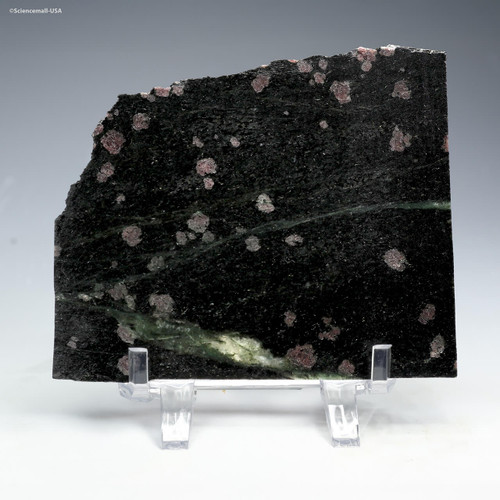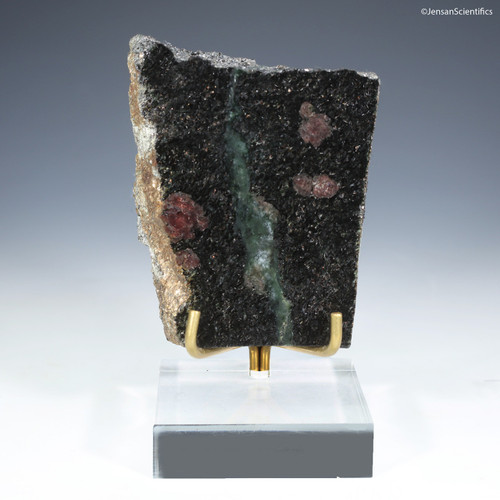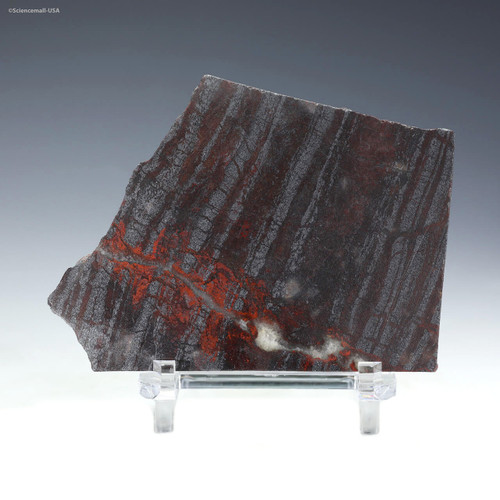Nuvvuagittuq Garnet Paragneiss Canada [23 g ~ 4.3 Ga]
Brand : Jensan Scientifics LLC
- SKU:
- JPT-81223
- Condition:
- New
- Availability:
- Usually ships in 24 hours.
- Weight:
- 1.00 LBS
- Minimum Purchase:
- 1 unit
- Maximum Purchase:
- 1 unit
- Shipping:
- Calculated at Checkout
Nuvvuagittuq "Faux Amphibolite" Hadean Garnet Paragneiss
From the remote Porpoise Cove of Northern Canada, this garnet-bearing paragneiss represents one of Earth's oldest known rocks — dating to approximately 4.3 billion years ago. This specimen offers visible crimson garnets within a dark, fine-grained metamorphic matrix — a visually stunning and scientifically significant relic from the Nuvvuagittuq Supracrustal Belt.
What Is a "Faux Amphibolite"?
Researchers coined the term “faux amphibolite” to describe this rock’s unusual composition — predominantly cummingtonite, an uncommon amphibole mineral. Unlike typical amphibolite, this variant features garnet porphyroblasts that enhance both its mineralogical and aesthetic appeal. Porphyroblasts Defined: Crimson garnets shimmer through this ancient rock like embers frozen in time. These almandine-rich porphyroblasts crystallized more than four billion years ago under searing amphibolite-facies metamorphism, at depths where pressure and heat reshaped the early crust (~650–700 °C). Their elegant alignment along foliation planes reveals "syn-tectonic growth" — they formed while the rock itself was still flowing and folding deep within the Earth. Each garnet holds subtle chemical zoning, a time capsule of elemental memory, recording the shifting temperatures and forces that forged our planet’s first stable crust.
Mineralogical Composition
Visible Minerals
- Garnet (Almandine-rich): Deep red, rounded crystals formed under peak metamorphic conditions.
- Biotite & Hornblende: Dark gray to greenish-black minerals that define the foliation and texture.
- Plagioclase Feldspar & Quartz: Fine-grained matrix minerals that lend compact structure and sheen.
- Magnetite or Pyrrhotite: Potential inclusions giving subtle metallic flecks and natural luster.
Texture and Structure
The gneissic banding and foliation reflect intense directional pressure and heat deep within the Archean crust. Folded layers along the specimen’s upper regions record ancient ductile deformation, while elongated “trains” of garnet crystals reveal syn-tectonic growth—meaning these garnets crystallized while the rock was still undergoing deformation.
Geological Significance of this Garnet Paragneiss
This rare specimen offers tangible evidence of early crustal recycling and metamorphic differentiation. The Nuvvuagittuq Greenstone Belt preserves isotopic signatures (Sm–Nd, U–Pb) suggesting Earth’s crust may have formed within 250 million years of planetary accretion. Its chemistry and texture provide clues to early oceanic hydrothermal systems and the beginnings of Earth’s geodynamic activity.
Collector Value and Focus
This authentic garnet paragneiss specimen showcases the Archean roots of our planet in miniature. It’s both an educational tool and a geological treasure — perfect for collectors, educators, or anyone fascinated by Earth’s Hadean and Archean history. Each piece is scientifically documented and comes with verified provenance from Porpoise Cove, Nuvvuagittuq Belt.
Product Specifications
- Size: 39 mm L × 36 mm W × 8 mm D
- Weight: 22.9 grams
- Location: Porpoise Cove, Nuvvuagittuq Belt, Northern Canada
What’s Included
- Certificate of Authenticity
- Display tag and information card
- XRF elemental analysis report
- Photographs (front, back, size cube, and tag)
Note: Plexiglass base and sizing cube not included. The specimen was lightly sprayed for photographic clarity.
Learning About Early Earth's History
Build your understanding of early Earth geology with this extraordinary Hadean-era metamorphic rock. Rich in garnet and deep scientific meaning, this piece from the Nuvvuagittuq Supracrustal Belt offers a direct connection to Earth’s first crustal evolution.
Free geology poster included — a perfect complement to your building foundational understanding of the geologic history of the early Earth.









